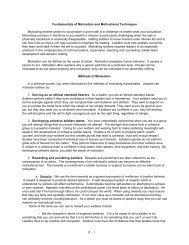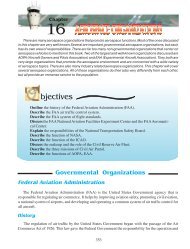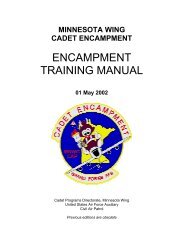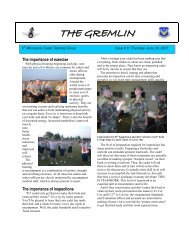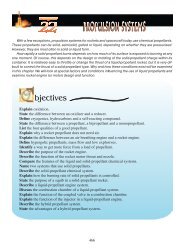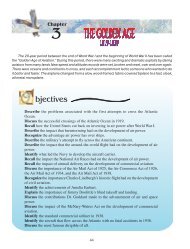and four conflict styles. Hammer begins by describing thefour general patterns: the Direct and Indirect and theEmotionally Restrained and the Emotionally ExpressiveCultural Patterns.Direct Cultural PatternsHammer explains that cultures with a more direct communicationstyle tend to frame their arguments andproblem-solving language directly and precisely. Thishelps all parties to understand the issues and interests atplay in a negotiation. According to Hammer, each party isresponsible for verbalizing its “own concerns and perspectivesand to verbally confront misperceptions andmisunderstandings that can arise.” 25 Such cultures,according to Hammer, tend to be comfortable with faceto-facenegotiations that allow both sides to uncover misunderstandings,air grievances, and iron out disagreements.These cultures are also more likely to value those whocan “tell it like it is” in ways that are both effective andappropriate. Good negotiators in these cultures are ableto assert their needs or those of their group while maintainingsome degree of politeness and tact. Hammer alsodescribed negotiations in these cultures to be typicallycharacterized by appeals to reason based on facts orstatistics. When problem-solving, they tend to “cut to thechase” and more often than not will focus on the solutionrather than relationships or process issues. 26 This conflictstyle fits comfortably on the low-context communicationside of Edward T. Hall’s low-high context continuum. 27Indirect Cultural PatternsUnlike cultures that are more direct, cultures that favorindirect communication patterns align more closely withthe high context end of Hall’s continuum. 28 Hammerdescribes these cultures as being tuned in to contextualmessages that communicate outside the realm of thespoken word. 29 In negotiation or conflict situations, heasserts that verbal messages are intended more for thesatisfaction of social expectations than to communicateinterests or needs. When engaged in a dispute, cultureswith an indirect style tend to view direct communicationbetween parties as having a strong potential for makingmatters worse. Another difference is a tendency to use amore indirect means of persuasion. Instead of appealingto reason, indirect cultures tend to concentrate on facework.Ting-Toomey and Oetzel defined facework as thewillingness and ability to “listen to the other person,respect the feelings of the other, and share personal viewpoints.”30 The importance of facework is evident in a preferencefor using third party intermediaries to settledisputes. Use of a trusted go-between allows all parties tosave face while the mediator works to repair relationshipsand reach a resolution at the same time. In contrast to thedirect style pattern of zeroing in on a resolution, the indirectcultural pattern is to approach problem-solving orconflict by focusing on repairing relationships. The solutionis continually adjusted through the work of a thirdparty until an acceptable resolution is reached.When working with the ICS-DEAD model, negotiatingteams should not become so focused on conflict style,that they forget the importance of enumerating interestsand important facts and figures. These are important tothe negotiation process regardless of the cultural context.However, the ICS-DEAD model can provide helpful insightinto how the data can be effectively introduced intothe process.Emotionally Expressive Cultural PatternsIn emotionally expressive cultures, displays of emotionduring a conflict tend to be expected and also valued. Inthese cultures, ventilating is generally accepted as a wayto externalize or let out emotion. 31 In fact, the failure toexternalize emotion in highly charged situations is oftenviewed with suspicion. Advising others to “relax” or “takeit easy” is generally not positively construed and can beperceived as insincerity. In some emotionally expressivecultures, humor can be an acceptable way to reduce tensions.Emotionally Restrained Cultural PatternsIn contrast to emotionally expressive cultures are theemotionally restrained patterns. In these cultures, strongfeelings tend to be suppressed even when a person isgreatly upset. Unlike expressive cultures, people from arestrained cultural background are apt to take a dim viewof any attempt at humor in an emotionally charged situation.Emotions, of course, are enacted, but are more likelyto emerge nonverbally and with minimal display. Byallowing a glimpse of the underlying passion and commitmentseething below the surface, these relatively subduedexpressions of feeling can serve as an effective communicationstrategy when dealing with others comfortablewith this pattern. Maintenance of a calm demeanor in theface of danger or high emotion tends to be highly prized.Consider these lines from Kipling’s poem, If:If you can keep your head when all about youAre losing theirs and blaming it on you,…you’ll be a man my son! 32The DEAD Conflict Styles 33Hammer’s Intercultural Conflict Styles-DEAD Modelidentifies four distinct styles of cross-cultural conflictresolution. The four conflict resolution styles are: (a)Discussion, (b) Engagement, (c), Accommodation, and (d)Dynamic. As described above, the four styles are furthersorted into four larger groupings of cultural patterns: (i)Direct and (ii) Indirect, and (iii) Emotionally Restrainedand (iv) Emotionally Expressive. The chart in Figure 1144
shows how the four cultural patterns intersect with thefour conflict resolution styles.The Discussion, Engagement, Accommodation, and DynamicConflict Styles form the ominous, yet oddly appropriateacronym DEAD. If one pays only scant attentionto differing communication patterns and styles of conflictresolution, talks are more likely to end up “dead inthe water.”Because the other parties in a negotiation cannot becounted on to be sensitive to our own preferences, it isdoubly important that we understand how they handleconflict and negotiation. Such knowledge gives us a powerfulnegotiating tool.Discussion Style. As the word discussion implies, peoplecomfortable with this style prefer to talk through problems,positions, issues, and interests. The Discussion style isdirect, but calm. “Say what you mean and mean what yousay,” is an American saying that describes this style. Factsand figures presented in a logical format are strong persuadersfor individuals using this conflict style. Remainingcalm while clearly describing issues, positions, andinterests is the hallmark of this style. Proponents of thisstyle believe that discussion reduces the possibility ofmisunderstanding while a “businesslike” atmospherekeeps everyone focused on issues and not personalities.The Discussion style aims for an expeditious completionof the negotiation. Unfortunately, this method for enhancingunderstanding is most effective when workingwith those who favor the same style. Negotiators fromcultures where other styles predominate may find aDiscussion-style negotiator either too direct or overlycold and calculating. They may feel that relationships aresacrificed just so the talks can proceed quickly. This styleshould seem familiar to most readers. It is the conflictand negotiation style that predominates in the U.S.Engagement Style. Like the Discussion style, Engagementalso has a preference for verbal directness in a negotiationor conflict situation. These two styles diverge in the waythey handle displays of emotion. The Engagement style isdirect and emotional. We might describe people who arecomfortable with the Engagement style as “wearing theirhearts on their sleeves.” They are comfortable sharingtheir feelings, showing both commitment and sincerity. 34Engagement-style negotiations tend to be animated andhighly emotional when compared with Discussion-styleinteractions. Displays of emotion by Engagement-stylenegotiators can make their Discussion-style counterpartsuncomfortable. On the other hand, anyone comfortablewith an Engagement style may read the Discussion styledemeanor as insincere or unwilling to acknowledge orengage with the intense feelings generated by the conflictor negotiation.DirectIndirectEmotionally RestrainedDiscussion Conflict Style• Direct• Emotionally RestrainedAccommodation Conflict Style• Indirect• Emotionally RestrainedEmotionally ExpressiveEngagementConflict Style• Direct• Emotionally ExpressiveDynamic Conflict Style• Indirect• Emotionally ExpressiveFigure 1. Intercultural Conflict Styles (ICS), also known as “TheDEAD Model.”Accomodation Style. The Accommodation style, like theDiscussion style, is emotionally restrained, but peoplepreferring this style tend to be indirect in the way theyapproach conflict resolution. This style relies on context,ambiguity, metaphor, and third party intervention toimprove any verbal confrontations between parties. 35Relational harmony is typically maintained by hidingone’s emotional discomfort. Those who are comfortablewith this style are adept at reading ambiguous high contextmessages. As previously stated, use of third partyintermediaries are common. In discussing conflict resolutionin Korea, the late L. Robert Kohls, a cross-culturaltraining pioneer, suggests one should locate a go-betweenearlier on in the process than you would in the U.S.According to Kohls, “the use of mediators is common inKorea and does not imply the extremity of conflict it doesin the United States.” 36 A person accustomed to a directstyle is likely to suffer from mind-blindness and may beunaware that a problem even exists. In such cases, a conflictmay suddenly burst forth “like a volcano exploding.” 37When the bewildered American asks the aggrievedparties what happened, they are likely to say, “We WEREtelling you very loudly,” but not in words.Dynamic Style. The last style in the ICS-DEAD frameworkis Dynamic. Like the Accommodation style, Dynamicnegotiators and disputants tend to use indirect messagesto settle disagreements, but with a more emotionally intenseverbal style. Hammer explains that the Dynamicstyle is marked by “strategic hyperbole, repetition of one’sposition, ambiguity, stories, metaphors, and humor alongwith greater reliance on third party intermediaries.” 38Dynamic negotiators are accustomed to working withintermediaries and are quite at home with displays ofanger or emotion. As indirect communicators, they arelikely to describe themselves as good observers of behaviorcapable of providing helpful solutions to all parties ina dispute.Discussion-style negotiators may view a Dynamic-stylecounterpart as an overly emotional person who rarelygets to the point. To discern underlying values, arrangingfor a third-party intermediary or go-between may be thebest way to uncover the underlying causes while still145
- Page 1 and 2:
VOLUME FOUR STRATEGIC PERSPECTIVESL
- Page 3 and 4:
VOLUME FOUR STRATEGIC PERSPECTIVESL
- Page 5 and 6:
VOLUME FOUR STRATEGIC PERSPECTIVESL
- Page 7:
VOLUME FOUR STRATEGIC PERSPECTIVESL
- Page 10 and 11:
12CHAPTER 12INTRODUCTION TO STRATEG
- Page 12 and 13:
12.1 Strategic Leadership: Defining
- Page 14 and 15:
mandates or resolutions that would
- Page 16 and 17:
and ambiguity, aspiring strategic l
- Page 18 and 19:
12.2 National Security StrategyThe
- Page 20 and 21:
within our borders has always been
- Page 22 and 23:
front common challenges like violen
- Page 24 and 25:
and our strategy, not sector earmar
- Page 26 and 27:
thinking about organizations. She m
- Page 28 and 29:
A systemic approach to failure is m
- Page 30 and 31:
The late W. T. Grant Company is a r
- Page 32 and 33:
the resources - setting the directi
- Page 34 and 35:
focal point for describing and inte
- Page 36 and 37:
Consequently, we do not restrict th
- Page 38 and 39:
paragraphs, Web pages, then edit an
- Page 40 and 41:
Web, can be viewed as a CS attempt
- Page 42 and 43:
How to evaluate users and contribut
- Page 44 and 45:
13CHAPTER 13LEADING PUBLIC &VOLUNTE
- Page 46 and 47:
13.1 Leadership for Volunteers:The
- Page 48 and 49:
13.2 Take Root: Volunteer Managemen
- Page 50 and 51:
QualificationsClearly list educatio
- Page 52 and 53:
and effectively track their volunte
- Page 54 and 55:
• Understand rules for recognitio
- Page 56 and 57:
• Send a birthday card.• Submit
- Page 58 and 59:
and tested more than six decades af
- Page 60 and 61:
specific interests of the donors, v
- Page 62 and 63:
tain) tax-exempt status from the In
- Page 64 and 65:
Smucker, 1999).The Internal Revenue
- Page 66 and 67:
culture is necessary to ensure the
- Page 68 and 69:
13.4 The New Look of TransparencyBy
- Page 70 and 71:
ees for a couple of reasons: One, i
- Page 72 and 73:
13.5 Public and Private Management:
- Page 74 and 75:
TABLE 1:FUNCTIONS OF GENERAL MANAGE
- Page 76 and 77:
3. Career System. The model corpora
- Page 78 and 79:
islative charter - the Clean Air Ac
- Page 80 and 81:
In controlling performance, Chapin
- Page 82 and 83:
14CHAPTER 14AIRPOWER ASSTRATEGIC LA
- Page 84 and 85:
14.1 Strategic Air Power: Fulfillme
- Page 86 and 87:
carry it out. Their daylight raids
- Page 88 and 89:
you did not rely on strategic bombi
- Page 90 and 91:
14.2 Warden and the Air Corps Tacti
- Page 92 and 93:
ecomes one of applying sufficient i
- Page 94 and 95:
tification, and a Jominian claim to
- Page 96 and 97: courage the rapid and widespread ex
- Page 98 and 99: it to influence physical players in
- Page 100 and 101: 14.4 Basic Air Force DoctrineAF Doc
- Page 102 and 103: earthquake-stricken Haiti. The worl
- Page 104 and 105: perspective. Airmen do not divide u
- Page 106 and 107: Command and ControlCommand and cont
- Page 108 and 109: 14.5 Should the US Maintain the Nuc
- Page 110 and 111: form of human government.” 20 Dem
- Page 112 and 113: obtainable goal. See the Global Zer
- Page 114 and 115: 15CHAPTER 15ORGANIZATIONAL CULTURE
- Page 116 and 117: 15.1 Organizational CultureBy Doria
- Page 118 and 119: Review. This action strives to unco
- Page 120 and 121: gram will serve and then having the
- Page 122 and 123: ticipating the changes being made b
- Page 124 and 125: Many years of working with change p
- Page 126 and 127: At the least, the areas of concern
- Page 128 and 129: 15.4 Developing an Innovative Cultu
- Page 130 and 131: CONCLUDING THOUGHTSIn an ever-chang
- Page 132 and 133: global issues. Businesses that poss
- Page 134 and 135: — Sees the big picture—the shif
- Page 136 and 137: 16CHAPTER 16STRATEGIC COMMUNICATION
- Page 138 and 139: 16.1 Principles of Strategic Commun
- Page 140 and 141: 16.2 The Art of NegotiationBy Brend
- Page 142 and 143: 16.3 Negotiating Effectively Across
- Page 144 and 145: hidden areas can act as cultural ho
- Page 148 and 149: maintaining the relationship. As th
- Page 150 and 151: 25 Mitchell R. Hammer, “Chapter 1
- Page 152 and 153: tural, socioeconomic, and psycholog
- Page 154 and 155: for the win-win," during which time
- Page 156 and 157: interests and, at worst, as a gun s
- Page 158 and 159: Public diplomacy is surely about mu
- Page 160 and 161: But public diplomats do not have th
- Page 162 and 163: Photo courtesy of the familyThe LEA
- Page 164: THE CADET OATHI pledge that I will



